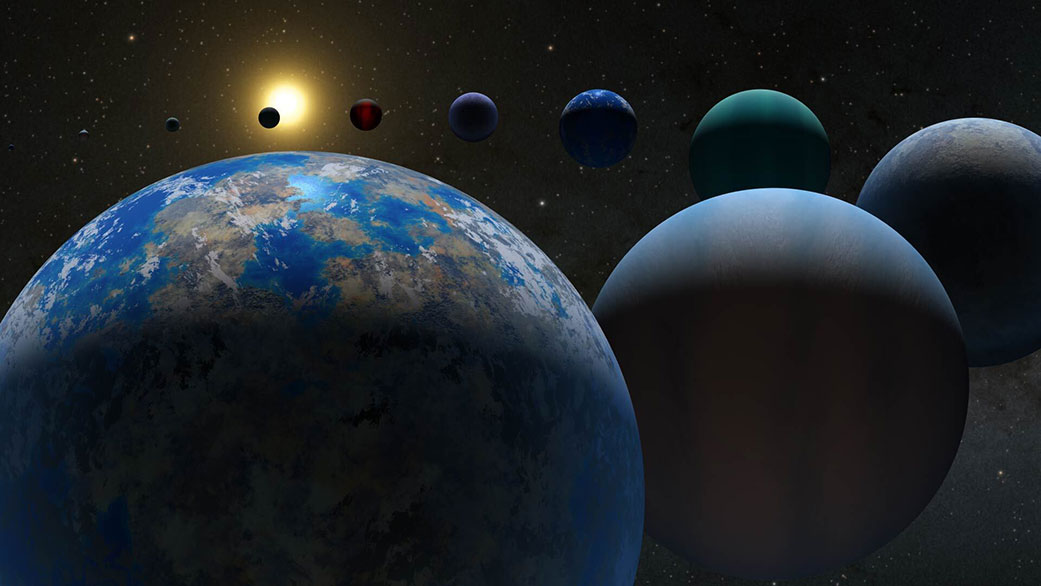Missing planets twice Earth's size may point to migrating worlds
The dichotomy arises during the first 50 million years of planetary history.

Supercomputer simulations have provided an explanation as to why so many exoplanets are either super-Earths or mini-Neptunes, with few planets in between.
Exoplanets can come in a variety of sizes and masses. If you were to plot on a graph how many planets of each size astronomers have discovered, you'd find two peaks: one at 1.4 times Earth's radius, and another at 2.4 times Earth's radius. Between them is a dip or valley, at around 1.8 times the radius of Earth, signifying the relative scarcity of planets of that size.
This "radius valley" doesn't occur by chance; something is happening that means that planets that are 1.8 times the size of Earth are found two or three times more infrequently. The new supercomputer simulations, from a team led by André Izidoro, a planetary scientist at Rice University in Texas, modeled the first 50 million years of a typical planetary system's existence to evaluate two leading hypotheses to explain the gap in planet sizes.
Related: 10 amazing exoplanet discoveries
One hypothesis is that the differences in composition between rocky super-Earths and hydrogen- and water-rich mini-Neptunes preferentially leads to the formation of planets of certain sizes. The other hypothesis is that super-Earths begin life as mini-Neptunes but lose their thick atmospheres as they migrate closer to their star due to gravitational interactions.
The new simulations support the migration model, and also explain why we frequently find chains of similarly sized exoplanets in what scientists dub near-resonant orbits. Resonance occurs when planets' orbital periods fall into multiples of each other; for example, an outer planet might orbit once for every two orbits of a planet interior to it. The new supercomputer simulations confirm that the inward migration of planets within the vast disk of dust and gas of a young star system causes resonant chains of worlds, like "peas in a pod."
However, astronomers know that the protoplanetary disk that permits this migration does not last forever. As the young star begins to generate more energy, its radiation wind blows the disk away; as the disk dissipates the planets become destabilized, prompting collisions between worlds and smaller protoplanets.
Get the Space.com Newsletter
Breaking space news, the latest updates on rocket launches, skywatching events and more!
"The migration of young planets towards their host stars creates overcrowding and frequently results in cataclysmic collisions that strip planets of their hydrogen-rich atmospheres," Izidoro said in a statement. "That means giant impacts, like the one that formed our moon, are probably a generic outcome of planet formation."
The simulations found that the migration of planets, the subsequent orbital destabilization and the loss of thick planetary atmospheres all conspires to preferentially create two populations of planets: the super-Earths that are rocky and dry, and the mini-Neptunes that did not migrate as far inward and are able to retain their thick atmospheres of hydrogen and water.
"I believe we are the first to explain the radius valley using a model of planet formation and dynamical evolution that self-consistently accounts for multiple constraints of observations," Izidoro said. "We're also able to show that a planet-formation model incorporating giant impacts is consistent with the peas-in-a-pod feature of exoplanets."
This "peas-in-a-pod" characteristic is commonly found in planetary systems such as TRAPPIST-1, which is home to seven rocky worlds of similar sizes in close, resonant orbits with one another. The new findings suggest that we should expect to find many more multi-planet systems with similarly sized planets in resonant orbits in the future.
The results were published on Nov. 2 in The Astrophysical Journal Letters.
Follow Keith Cooper on Twitter @21stCenturySETI. Follow us on Twitter @Spacedotcom and on Facebook.
Join our Space Forums to keep talking space on the latest missions, night sky and more! And if you have a news tip, correction or comment, let us know at: community@space.com.

Keith Cooper is a freelance science journalist and editor in the United Kingdom, and has a degree in physics and astrophysics from the University of Manchester. He's the author of "The Contact Paradox: Challenging Our Assumptions in the Search for Extraterrestrial Intelligence" (Bloomsbury Sigma, 2020) and has written articles on astronomy, space, physics and astrobiology for a multitude of magazines and websites.









